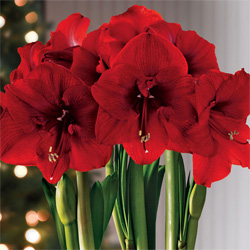Weekend Gardening: What To Do With Those Holiday Plants
December 28, 2013
 People often give and receive decorative plants during the Christmas season. Many of these plants can last long past the holidays, but only if you care for them properly.
People often give and receive decorative plants during the Christmas season. Many of these plants can last long past the holidays, but only if you care for them properly.
Use the following tips to keep Christmas cactus, poinsettia, amaryllis, kalanchoe, and cyclamen healthy and vibrant long after the holidays are over.
Light & Water Conditions
Keep your holiday plants in bright, indirect light, such as a sunny window. You can also put plants under incandescent or fluorescent lamps if a room is too dim.
Keep the room temperature cool. The ideal temperature ranges are 65º to 75ºF during the day and 50º to 60ºF at night.
Make sure the plants are watered enough to stay evenly moist, but do not overwater. Even Christmas cactuses need to be regularly watered since they are not true cactuses.
Flowering
Most plants are already flowering when you give or receive them. Eventually the flowers will fade and you should remove them.
You can prepare some plants for next season’s flowering. Remember that plants like poinsettia and Christmas cactus need to be kept away from artificial light at night to stimulate flowering, usually beginning around October.
 Amaryllis
Amaryllis
Since amaryllis is a bulb, it easily flowers if you force the bulb. After the last flower fades, remove the bloom stalk, but let the leaves continue to grow. Keep amaryllis under bright light and fertilize it regularly.
In late summer, the leaves will die and the bulb will go into a resting stage. Reduce the amount of water it receives and store the bulb in a cool, dry place for two to three months.
Begin watering again and the bulb should reflower in four to six weeks.
Poinsettia
Poinsettias are hard for home gardeners to force to reflower.
When the poinsettia begins to drop its leaves, this signals the start of its resting stage. At this time, only water the poinsettia often enough to keep the stems and roots from drying out.
In April, prune the stems to six inches high, resume a regular watering and fertilization schedule, and place it where it will receive bright light that is not direct.
Planting
Most holiday plants are cold-sensitive, so only people in the southern part of Florida can consider planting their holiday plants outdoors without too much worry. Residents in northern parts of Florida can try growing their plant outdoors, but will most likely need to pay attention to weather reports and have some way of protecting plants from the cold.
Select the plants that have remained healthy and lush, and plant them after the chance of frost is past.
Poinsettias
Plant your poinsettia in a sunny spot that will not receive artificial light at night. The soil should be well drained.
Cut off fading bracts, leaving four to six inches of stem on the branches. Mulch around the plant, and keep it well watered during establishment.
Fertilize monthly from May to September.
Prune regularly during the growing season to keep the poinsettia from looking “leggy.” Stop pruning in September and flower buds will form in October.
If the plant was damaged by cold, cut it back to 12 to 18 inches of the ground or to living tissue in the spring after the chance of frost is passed.




Comments